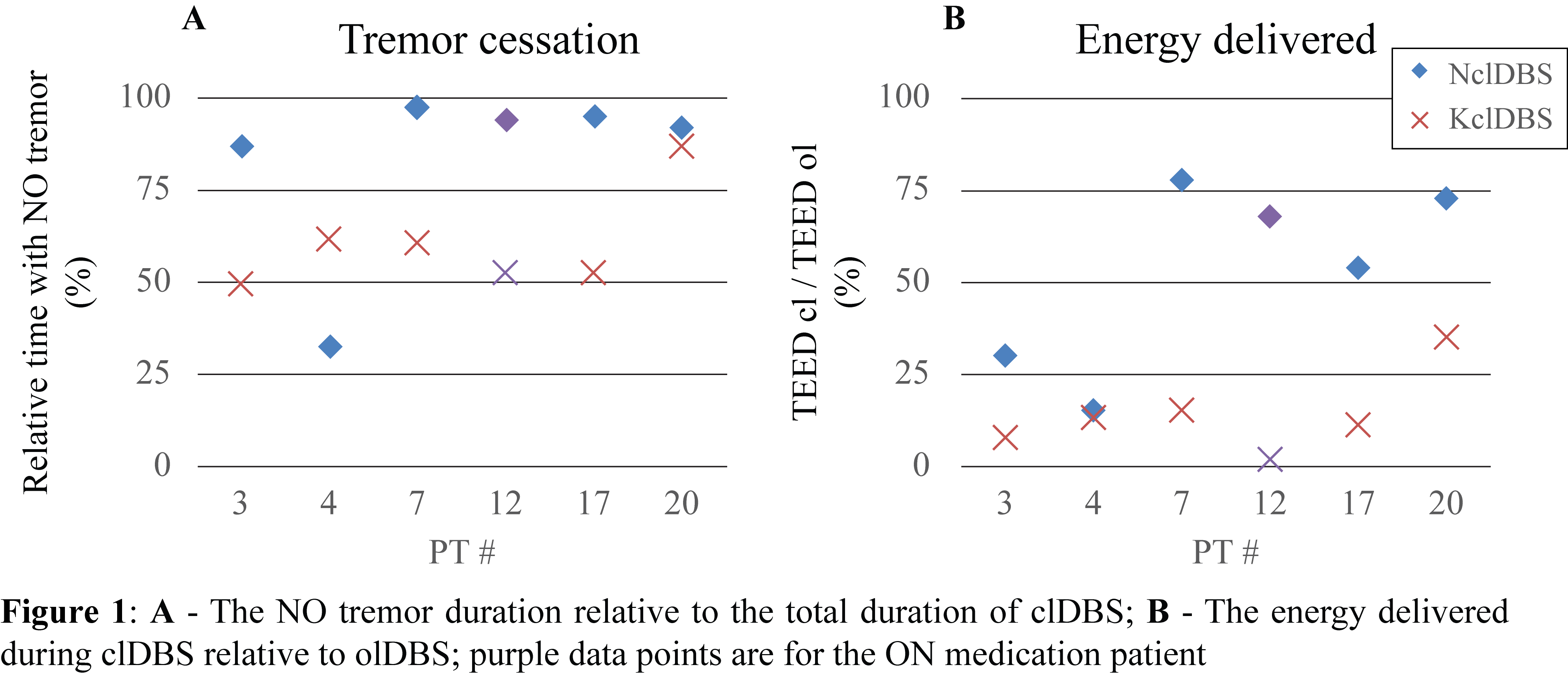Session Information
Date: Tuesday, June 6, 2017
Session Title: Therapy in Movement Disorders
Session Time: 1:45pm-3:15pm
Location: Exhibit Hall C
Objective: Compare safety, tolerability, efficiency and efficacy of closed loop DBS (clDBS) of the subthalamic nucleus (STN) for resting tremor in Parkinson’s disease (PD) using a neural (NclDBS) or kinematic control variable (KclDBS).
Background: clDBS increases or decreases neurostimulation intensity in response to a control variable (neural or kinematic marker) compared to open loop which is on all the time.
Methods: Safety and tolerability of N- and KclDBS1 were evaluated in 21 PD subjects (30 STNs) implanted with a sensing neurostimulator plus firmware upgrade (Activa® PC+S-NexusD3, Medtronic Inc., FDA-, IDE-, IRB-, and CA Medicare-approved). The Nexus-D system allows bi-directional communication between the Activa® PC+S and a portable computing device (PC). The PC informs the Activa® PC+S to adjust stimulation using preset, safe parameters. STN LFPs were recorded from electrodes 0–2 or 1–3 of the DBS lead (model 3389, Medtronic, Inc.) and 140 Hz DBS was administered through electrode 1 or 2. KclDBS used a kinematic measure of tremor recorded by a gyroscope sensor in a wearable watch (LG G watch); NclDBS used the resting state STN local field potential beta band power. In 6 tremor dominant (TD) PD subjects with different strengths of STN beta band power, we measured the percentage of stimulation time with ‘no’ tremor (less than 0.15 rad/s) and the total electrical energy delivered (TEED) during clDBS versus during continuous open loop DBS (olDBS), for NclDBS and KclDBS, delivered for > 20 minutes. 5/6 subjects were off medication.
Results: N- and KclDBS were safe and tolerable in all subjects and no adverse effects were reported. For the 6 TD PD subjects NclDBS resolved tremor for an average of 83% of the trial using average of 53% of TEED olDBS, whereas KclDBS resolved tremor for 61% of the trial using 14% of TEED olDBS, Figure 1. Differences depended on the strength of resting state STN beta power and whether tremor was intermittent or continuous. [figure1]
Conclusions: STN clDBS was safe and tolerable in all subjects. Both N- and KclDBS were more energy efficient than olDBS. NclDBS resolved tremor for longer than KclDBS but was less efficient. The efficacy and efficiency of N- and KclDBS were influenced by the strength of STN beta band power and whether tremor was intermittent. Optimal clDBS strategies for resting tremor may use a combination of neural and kinematic control variables and are more efficient than olDBS.
References: 1. Malekmohammadi, M., Herron, J., Velisar, A., Blumenfeld, Z., Trager, M. H., Chizeck, H. J. and Brontë-Stewart, H. (2016), Kinematic Adaptive Deep Brain Stimulation for Resting Tremor in Parkinson’s Disease. Mov. Disord., 31: 426–428. doi: 10.1002/mds.26482
To cite this abstract in AMA style:
A. Velisar, J. Herron, J. SYRKIN-NIKOLAU, Z. Blumenfeld, M. TRAGER, T. MARTIN, H. CHIZECK, H. Bronte-Stewart. Closed Loop STN DBS for Tremor in Parkinson’s disease using a Neural or Kinematic Signal [abstract]. Mov Disord. 2017; 32 (suppl 2). https://www.mdsabstracts.org/abstract/closed-loop-stn-dbs-for-tremor-in-parkinsons-disease-using-a-neural-or-kinematic-signal/. Accessed December 7, 2025.« Back to 2017 International Congress
MDS Abstracts - https://www.mdsabstracts.org/abstract/closed-loop-stn-dbs-for-tremor-in-parkinsons-disease-using-a-neural-or-kinematic-signal/

